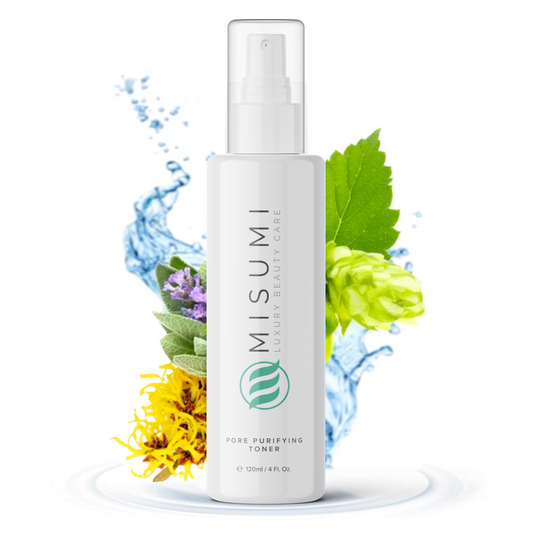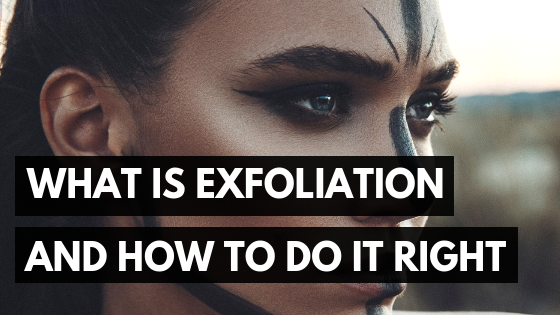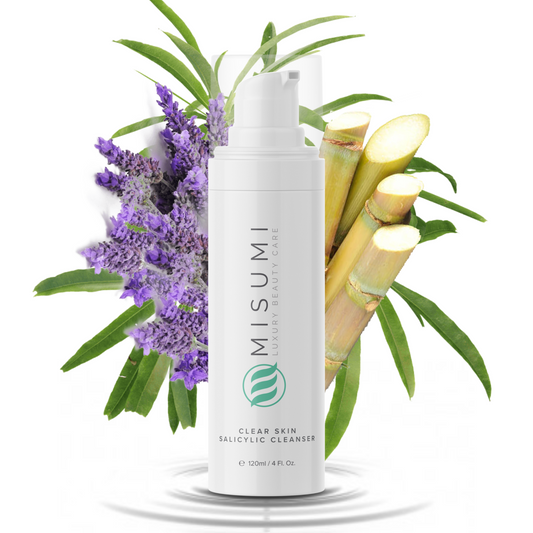New to exfoliation?
Exfoliating the skin properly and regularly is crucial in getting that flawless glow you've always wanted. Trying to include regular exfoliation in your skincare regimen is definitely worth your while. But exfoliation can be tricky - especially if you don't really know what you're doing.
But we're here to make it easy.
There's no need to worry about ending up with a red, blemished face before some important event. With the right product and the right instructions, you'll be on your way to a bullet-proof skincare routine for a perfect complexion.
What Exactly is Exfoliation?

Exfoliation is the process of removing skin cells from the skin's outermost layer to improve the appearance and health of the skin.
People believe this common practice originated in Ancient Egypt, and one of the first chemical agents used to exfoliate the face was tartaric acid, typically found in grapes.
Regardless of its origins, exfoliation is now present in almost every professional facial treatment, and it's also promoted as an important part of your home skincare routine with many over-the-counter exfoliating masks, creams, scrubs, peels, and even natural remedies.
It sounds simple, but it's important to do it right. Exfoliation can easily damage your skin and make things worse.
Some arguments support the claim that exfoliation is not suitable for every skin type, but this really depends more on the method, product, and frequency of exfoliating rather than exfoliation as a whole.
Why is it Good to Exfoliate?

To give this question a good answer, we first need to help you understand your skin's physiology.
The skin you live in is a dynamic, live organ in a continuous cycle of replacing cells. Old cells die, and new ones are reproduced. This happens as frequently as every 30 days or so and enables the skin to function optimally and protect the body.
But as we age, the process slows down, and there's a build-up of worn-out, dead cells that slowly clog the pores, messing with the function of the live cells beneath. To prevent this, we've learned to exfoliate the skin, bringing back its youthfulness and glow.
When we start removing dead skin cells from the skin's surface, there's room for new cells to emerge. These cells are not damaged, pigmented, clogged, or irritated. So, in other words, if you want smooth skin, you must take proper care of it, including exfoliation.
The Different Types of Exfoliation

There are two ways to exfoliate your skin. One way is by scrubbing the skin with an abrasive product or ingredient, and the other is by using an active chemical agent to dissolve dead skin cells.
Physical Exfoliation
Physical or mechanical exfoliation is when a tool, material, or facial scrub physically removes the outermost superficial layer of skin, removing dead skin cells, debris, and other bits.
If you go for physical exfoliation, you'll need to rub the skin manually. The most common methods include cleansing scrubs, brushes, loofahs, exfoliating mitts, and microfiber cloths. Ingredients you can use for mechanical exfoliation include sugar, salt crystals, pumice, or even crushed almond shells.
What Makes Physical Exfoliators a Good Choice for You?
It's really easy to do. All you need is a clean washcloth and a good moisturizer. You can make some pretty fabulous DIY home facial scrubs with natural ingredients, such as sugar and salt crystals. The results might not be as effective as chemical exfoliants, but they are immediate.
Thirdly, the over-the-counter options for physical exfoliation are endless, and you can find a scrub for almost every part of your body and every skin type.

You need to be careful when using physical exfoliators. Scrubbing too hard or using abrasive materials can irritate your skin and cause rashes, swelling, and redness. This is because the skin loses too much transepidermal water. You'll need to use a moisturizer, oil, or serum after exfoliating.
Additionally, this type of exfoliation can be harsh on dry skin no matter how hard you scrub, so start with gentle exfoliation treatments.
Another popular physical exfoliating method is the microdermabrasion technique. This light cosmetic treatment uses an exfoliating material like crystals or diamond flakes and machine-based suction to lift up the skin during exfoliation. It's not an invasive procedure, but it's best performed by a trained skincare professional. Unlike other physical exfoliants, microdermabrasion is suitable for all skin types, and you can read more about it in detail here.

Chemical Exfoliation
The name might come off a little strong and scary, but there's nothing to be worried about. The word "chemical" describes how the procedure works on the face. For example, with physical exfoliators, you manually scrub the face, while with a chemical exfoliator, the active ingredient inside the formula does all the work for you.
How Do Chemical Exfoliators Work?
The procedure includes creams, scrubs, and chemical peels that contain alpha and beta hydroxy acids or enzymes that loosen the glue that holds the cells together. After the bonds are loosened, the dead skin cells are detached from the rest of the skin and slowly dissolve. This way, the skin can be penetrated easily, and the products act on the living cells beneath the surface.
Why is Chemical Exfoliation a Good Option for You?

The general rule of thumb is that chemical exfoliation in lower concentrations is gentler on the skin, and it's probably a better option for people with sensitive or dry skin.
Chemical exfoliators are also effective in treating common skin problems. This type of exfoliation is an amazing treatment for acne and acne scars and symptoms of aging like wrinkles, fine lines, dark spots, discoloration, and saggy skin. Chemical exfoliants are also great for sensitive, dry, and delicate skin.
The main difference between physical and chemical exfoliators like glycolic acid is that the latter penetrates the skin deeper, reaches the dermis, and acts on the living cells causing functional changes. Physical exfoliants work only on the skin's surface, making them ineffective in treating fine lines and wrinkles, acne, and acne scars.
What About the Precautions of Using Chemical Exfoliators?
There are a few things you should be careful of when it comes to this exfoliation method.

The first one is the concentration and pH value of the product you're using. Some professionals may use high concentrations for certain conditions. However, when you're buying a product for home use, remember that high concentrations and low pH values can lead to burning and redness. A mild burning sensation is normal, but the mask shouldn't bring you to tears! That means something is wrong.
Be careful about the acid used in the product. Some acids have greater bioavailability, meaning they irritate the skin more than others. Here are some general guidelines regarding commonly used acids in chemical products.
Alpha Hydroxy Acids
AHAs are a group of chemicals that strongly affect the two top layers of our skin. They act by loosening the bonds between the cells on the surface, getting rid of dead skin cells, and penetrating the skin deeper to act on the living cells inside the dermis. They stimulate collagen production and help the skin maintain its youth and elasticity.
The best-known alpha hydroxy acids are glycolic, lactic, and citric acid. Glycolic is the strongest and most effective, while lactic acid is much more gentle and best for sensitive skin.

Beta Hydroxy Acid
When we talk about the beta hydroxy acids used in cosmetics, we mean salicylic acid. BHA is stronger than AHAs, and its molecules are oil-soluble. This acid goes deep into your hair follicles; it will remove dead skin cells and unclog your pores. Salicylic acid is potentially more effective than AHAs in battling acne and scars, but it also irritates the skin, and it's not the first choice for people with sensitive and dry skin.
The two acid groups are close cousins and share many benefits but differ in some critical functions. You can check out this article about the differences between AHA and BHA to learn more about them.
Retinoids
Retinoids are also a class of chemical compounds derived from vitamin A. They are used in medicine for various health issues and topically for the skin. Retinoids are most commonly used to treat inflammatory skin disorders, stimulate cell turnover (e.g., psoriasis), photoaging, and wrinkles. Currently, research is being done into their ability to treat skin cancers.
Although you can find many over-the-counter products with retinoids, always consult your dermatologist or doctor before starting a retinoid treatment, as they have side effects and can make your skin more sensitive to sunlight.

How to Choose the Right Type of Exfoliation
Your exfoliating method will vary depending on your skin type. From dry to oily skin, not everything works best for everyone. Here are some general rules.
Sensitive Skin
If your skin gets irritated or breaks out after trying a new product, you're probably dealing with a sensitive skin type. Go for gentle chemical exfoliation. Although both AHA and BHA can be great for easily irritated skin in low concentrations, the ultimate starter acid is lactic acid.
Take it from there - see how your skin reacts, and you can slowly introduce stronger alternatives.

Dry Skin
Generally, the most recommended products for dry skin are the ones that include AHA in their formulation. And if you have read a thing or two about AHA, you wouldn't be surprised.
Apart from AHAs, DIY and over-the-counter physical exfoliants can also work well for dry patches and skin. However, over-exfoliating, scrubbing too hard, or using a strong product can worsen dry skin. If you're going chemical, we recommend glycolic and citric acids.
Oily and Acne-Prone Skin
BHAs' oil-loving molecules are perfect for breaking down excess oil, clearing the pores, and leaving the skin clean and oil-free. Besides salicylic acid and glycolic acid, an over-the-counter physical scrub is also a good choice for oily skin.

Combination Skin
Combination skin is a little tricky. Instead of focusing on one exfoliant method, you should combine a few topical skin care products for specific areas. This is because combination skin is a combination of oily and dry.
Use an AHA-based chemical exfoliant for your dry areas and a BHA-based chemical exfoliant or a physical scrub for your oily areas. Treat the dry areas one day and the oily areas the next. Don't do everything in one day; otherwise, you'll over-exfoliate the skin.
Normal Skin
People with a normal skin type don't get irritated as easily and are free to experiment with many exfoliation methods until they find the one they like best. Just remember - don't overdo it by using too many products in a short period. Stick to one product at a time and give it a few weeks before you decide whether you like it.

The Benefits of Exfoliation
Exfoliation Unclogs the Pores
The purpose of exfoliation is to clear out clogged pores from dead skin cell buildup. Physical exfoliation accomplishes this by removing dead skin cells, while chemical exfoliation dissolves them.
Exfoliation Shrinks Large Pores
Some people have larger pores than others, and there isn't much they can do about it. However, large pores can also result from a buildup of dirt, dead skin cells, debris, and excess oil. When the pores are clear, they are tighter and much less noticeable.

Exfoliation Reduces the Appearance of Superficial Scars and Wrinkles
With exfoliation, you increase blood circulation, break down toxins, stimulate collagen production, and encourage new skin cells to come through. Removing damaged skin cells helps get rid of superficial marks, spots, and scars on the face because the cells underneath are fresh, new, and undamaged.
The increase in collagen production helps the skin heal faster and more effectively and maintain its elasticity, which further prevents the formation of new wrinkles and scars.
Speaking of aging, they also help with hyperpigmentation, removing darker skin tone patches and giving you brighter skin.
Skin Exfoliation Boosts Absorption of Skincare Products
Sometimes the products we use for our skin are great, but they can't reach our skin's pores because of everything clogging them. Even if we can't see this with the naked eye, the question of how well our skin absorbs the active ingredients of a product always remains.
The order you apply different products in a skincare routine is so important. Start with cleansing, toning, and exfoliating, and apply serums and moisturizers at the end. Never apply a mask or cream on your face before you've cleaned it.
When exfoliants remove the outer layer of dead and damaged cells, the other products can act more easily on the living cells beneath them.

Precautions and Side Effects
Over-exfoliating can strip away the skin from its natural oils, which causes excess oil production and new, more frequent breakouts. Exfoliating is great for wrinkle reduction, but over-exfoliating can lead to more wrinkles and fine lines over time because it makes the skin thinner.
If you use abrasive products, exfoliation can lead to burning, irritation, and blemished or red skin.
How to Safely Exfoliate Your Skin

Adjust Your Skin Care Routine
When introducing exfoliation into your skincare routine, adjust the other products you use. For example, topical prescriptions or over-the-counter products can give you very sensitive skin or other skin issues. In this case, using an exfoliant will only make things worse.
Forgetting to use a moisturizer after exfoliating can also make your skin dry, dull, and even blemished.
Do your Research and Choose Right
Take your time to learn all about the procedure, methods, and products before making a decision. As mentioned, not every exfoliant is good for every skin type. Experiment and try new things - just not too frequently!
Exfoliation is great, and your skin needs it - there's no question about that. But finding the right exfoliating methods can take some time - so be patient.

Start Slowly - Don't Over Do It
If this is your first time trying an exfoliation routine, start slowly. Whether you're using a scrub or chemical exfoliator, exfoliate once a week. Use a mild chemical exfoliator. Don't reach for higher concentrations right away. Results won't come sooner, but the damage will.
After a couple of weeks, start exfoliating three times a week and see how that goes. There are no strict schedules or rules you are obliged to follow.
And remember - always listen to your skin after you've put it through a new treatment.
Moisturize
It's important to lock in hydration after exfoliating, so always apply a moisturizer at the end of your skincare routine.
References
Skincare Bootcamp: The Evolving Role of Skincare
Dual Effects of Alpha-Hydroxy Acids on the Skin
Hydroxy Acids, the Most Widely Used Anti-aging Agents










